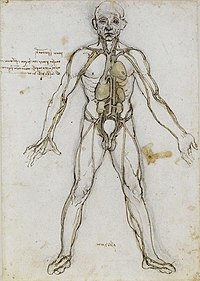
Photo from wikipedia
Purpose Our research was designed to analyse the postoperative clinical results of patients suffering from single-segment thoracic ossification of the ligamentum flavum (TOLF) combined with dural ossification (DO) who underwent… Click to show full abstract
Purpose Our research was designed to analyse the postoperative clinical results of patients suffering from single-segment thoracic ossification of the ligamentum flavum (TOLF) combined with dural ossification (DO) who underwent posterior laminar decompression and internal fixation. Methods This retrospective research included thirty-two patients who underwent surgery for ossifying the ligamentum flavum in the thoracic spine between January 2016 and January 2020. Patients were fallen into one group included patients with evidence of DO during surgery, and the other group included patients without evidence of DO. We assessed and compared general clinical characteristics and health-related outcomes before surgery and during follow-up. Results The DO group had a longer operation duration, more blood loss, and longer hospital stay (operation time: 94.75 ± 6.78 min vs. 80.00 ± 10.13 min, p < 0.001; blood loss: 331.67 ± 50.06 ml vs. 253.00 ± 48.24 ml, p < 0.001; length of hospital stay: 13.83 ± 2.76 days vs. 10.05 ± 2.33 days, p < 0.001). Complications There were 12 cases of cerebrospinal fluid leakage and 1 case of superficial wound infection in the DO group. However, the neurological recovery and health-associated quality of life (HRQOL) scores showed no statistically significant changes between the DO and non-DO groups (p > 0.05). Conclusions Posterior laminectomy and internal fixation combined with intraoperative resection of the ossified ligamentum flavum and dura is an efficient and relatively safe method for treating TOLF with DO, which can provide satisfactory results. Moreover, DO had no significant effect on postoperative neurological recovery and health-related quality of life scores.
Journal Title: Frontiers in Surgery
Year Published: 2022
Link to full text (if available)
Share on Social Media: Sign Up to like & get
recommendations!